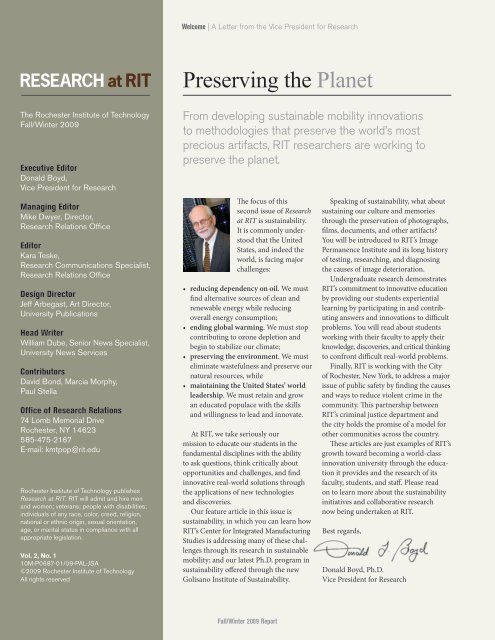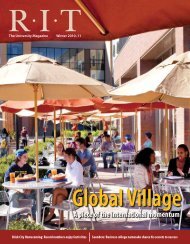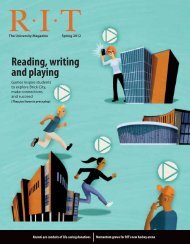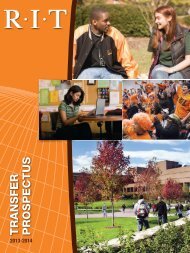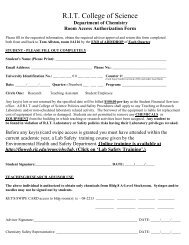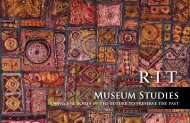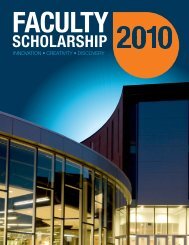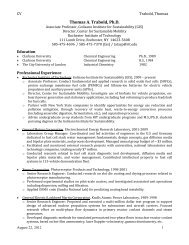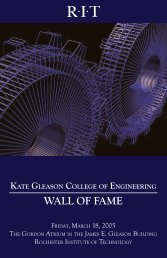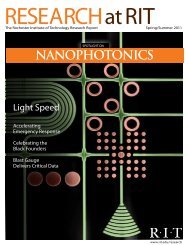Fall / Winter 2009 - Rochester Institute of Technology
Fall / Winter 2009 - Rochester Institute of Technology
Fall / Winter 2009 - Rochester Institute of Technology
You also want an ePaper? Increase the reach of your titles
YUMPU automatically turns print PDFs into web optimized ePapers that Google loves.
Welcome | A Letter from the Vice President for Research<br />
RESEARCH at RIT<br />
The <strong>Rochester</strong> <strong>Institute</strong> <strong>of</strong> <strong>Technology</strong><br />
<strong>Fall</strong>/<strong>Winter</strong> <strong>2009</strong><br />
Executive Editor<br />
Donald Boyd,<br />
Vice President for Research<br />
Managing Editor<br />
Mike Dwyer, Director,<br />
Research Relations Office<br />
Editor<br />
Kara Teske,<br />
Research Communications Specialist,<br />
Research Relations Office<br />
Design Director<br />
Jeff Arbegast, Art Director,<br />
University Publications<br />
Head Writer<br />
William Dube, Senior News Specialist,<br />
University News Services<br />
Contributors<br />
David Bond, Marcia Morphy,<br />
Paul Stella<br />
Office <strong>of</strong> Research Relations<br />
74 Lomb Memorial Drive<br />
<strong>Rochester</strong>, NY 14623<br />
585-475-2167<br />
E-mail: kmtpop@rit.edu<br />
<strong>Rochester</strong> <strong>Institute</strong> <strong>of</strong> <strong>Technology</strong> publishes<br />
Research at RIT. RIT will admit and hire men<br />
and women; veterans; people with disabilities;<br />
individuals <strong>of</strong> any race, color, creed, religion,<br />
national or ethnic origin, sexual orientation,<br />
age, or marital status in compliance with all<br />
appropriate legislation.<br />
Vol. 2, No. 1<br />
10M-P0687-01/09-PAL-JSA<br />
©<strong>2009</strong> <strong>Rochester</strong> <strong>Institute</strong> <strong>of</strong> <strong>Technology</strong><br />
All rights reserved<br />
Preserving the Planet<br />
From developing sustainable mobility innovations<br />
to methodologies that preserve the world’s most<br />
precious artifacts, RIT researchers are working to<br />
preserve the planet.<br />
The focus <strong>of</strong> this<br />
second issue <strong>of</strong> Research<br />
at RIT is sustainability.<br />
It is commonly understood<br />
that the United<br />
States, and indeed the<br />
world, is facing major<br />
challenges:<br />
• reducing dependency on oil. We must<br />
find alternative sources <strong>of</strong> clean and<br />
renewable energy while reducing<br />
overall energy consumption;<br />
• ending global warming. We must stop<br />
contributing to ozone depletion and<br />
begin to stabilize our climate;<br />
• preserving the environment. We must<br />
eliminate wastefulness and preserve our<br />
natural resources, while<br />
• maintaining the United States’ world<br />
leadership. We must retain and grow<br />
an educated populace with the skills<br />
and willingness to lead and innovate.<br />
At RIT, we take seriously our<br />
mission to educate our students in the<br />
fundamental disciplines with the ability<br />
to ask questions, think critically about<br />
opportunities and challenges, and find<br />
innovative real-world solutions through<br />
the applications <strong>of</strong> new technologies<br />
and discoveries.<br />
Our feature article in this issue is<br />
sustainability, in which you can learn how<br />
RIT’s Center for Integrated Manufacturing<br />
Studies is addressing many <strong>of</strong> these challenges<br />
through its research in sustainable<br />
mobility; and our latest Ph.D. program in<br />
sustainability <strong>of</strong>fered through the new<br />
Golisano <strong>Institute</strong> <strong>of</strong> Sustainability.<br />
Speaking <strong>of</strong> sustainability, what about<br />
sustaining our culture and memories<br />
through the preservation <strong>of</strong> photographs,<br />
films, documents, and other artifacts?<br />
You will be introduced to RIT’s Image<br />
Permanence <strong>Institute</strong> and its long history<br />
<strong>of</strong> testing, researching, and diagnosing<br />
the causes <strong>of</strong> image deterioration.<br />
Undergraduate research demonstrates<br />
RIT’s commitment to innovative education<br />
by providing our students experiential<br />
learning by participating in and contributing<br />
answers and innovations to difficult<br />
problems. You will read about students<br />
working with their faculty to apply their<br />
knowledge, discoveries, and critical thinking<br />
to confront difficult real-world problems.<br />
Finally, RIT is working with the City<br />
<strong>of</strong> <strong>Rochester</strong>, New York, to address a major<br />
issue <strong>of</strong> public safety by finding the causes<br />
and ways to reduce violent crime in the<br />
community. This partnership between<br />
RIT’s criminal justice department and<br />
the city holds the promise <strong>of</strong> a model for<br />
other communities across the country.<br />
These articles are just examples <strong>of</strong> RIT’s<br />
growth toward becoming a world-class<br />
innovation university through the education<br />
it provides and the research <strong>of</strong> its<br />
faculty, students, and staff. Please read<br />
on to learn more about the sustainability<br />
initiatives and collaborative research<br />
now being undertaken at RIT.<br />
Best regards,<br />
Donald Boyd, Ph.D.<br />
Vice President for Research<br />
<strong>Fall</strong>/<strong>Winter</strong> <strong>2009</strong> Report


